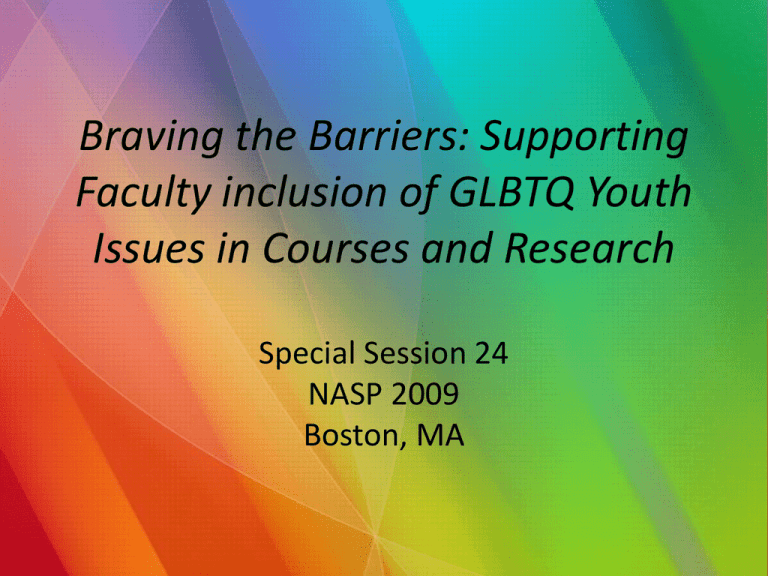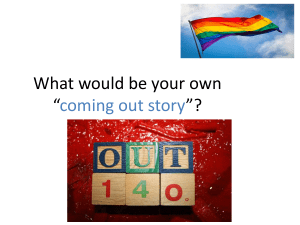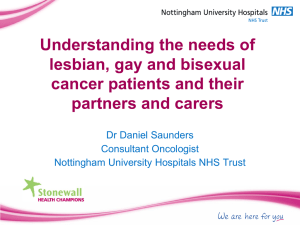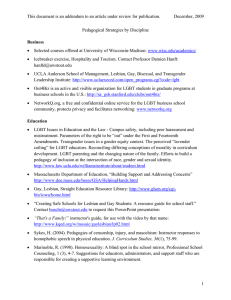
Braving the Barriers: Supporting
Faculty inclusion of GLBTQ Youth
Issues in Courses and Research
Special Session 24
NASP 2009
Boston, MA
Why Address LGBT Youth? Growing
up LGBT in America
Eliza Dragowski
Brooklyn College -- CUNY
• The interactions between developmental
processes, family and peer relationships and
assimilation into community life are
undoubtedly very complex for LGBT youth
• Discussion of life experiences of LGBT youth
has to be framed in social contexts of these
youth’s lives, because of cultural stigma they
face. (D’Augelli, 2006).
HETEROSEXISM & HOMOPHOBIA
• In spite of some legal victories, laws prohibiting
discrimination persist in excluding LGBT people in many
areas of human rights protections.
• “Gay and lesbian youth are not like other adolescents.
Their difference stems from their status as members of one
of the most hated and despised minority groups in the
country” (Martin quoted in Owens, 1998, p. 10).
• LGBT children are educated by institutions that “that
appear to be doing their level best to simultaneously
socialize children into citizenship and away from queer
futures … no other minority is so faced with medical and
educational institutions intent on their eradication prior to
their adulthood” (Mayo, 2006, p.472).
February 20, 2009, The New York Times
Tamer ‘Rent’ Is Too Wild for Some Schools
By Patric Healy
“Too provocative, in the view of some high school
officials and parents. At least three of the
planned high school productions, in California,
Texas and West Virginia, have been canceled after
administrators or parents raised objections about
the show’s morality, its portrayals of
homosexuality and theft, and its frank
discussions of drug use and H.I.V., according to
administrators, teachers and parents involved in
those cases.”
http://www.nytimes.com/2009/02/20/theater/20rent.html?_r=1&scp=1&sq=rent&st=cse
INTERNALIZED HOMOPHOBIA
• LGBT youth are likely to incorporate these
negative feelings towards homosexuality into
their own self-image, resulting in varying degrees
of internalized homophobia (IH).
• IH can in turn not only promote a basic mistrust
for the person’s sexual and interpersonal identity,
but often remains an important factor in the
LGBT youth’s psychological adjustment
throughout life (Meyer, 2003).
Developmental Challenges
As they form their identity and learn how to
master the demands of their place in the
world, LGBT must face additional challenges of
living with a stigmatized identity and coping
with heterosexism and internalized
homophobia.
• The “coming out” process is usually marked by few
resources available to LGBT youth. Most societal social
and cultural structures are built to accommodate
heterosexual mating (Rotheram-Borus & Langabeer,
2001), thus limiting opportunities for exploration and
role testing (Bohan, 1996).
• Youth who choose to “come out” or who cannot “pass”
often face the full forces of harassment, discrimination,
and victimization by their peers, teachers, families, and
the society at large (D’Augelli, 1992; Dean, Wu, &
Martin, 1992; Hunter, 1990; Remafedi, 1987; SavinWilliams, 1994).
• As a result, many LGB youth remain hidden, making
LGB youth not only different from the cultural ideal,
but also completely alone (Bohan, 1996).
• LGBT youth who engage in “passing” are often motivated by
avoidance of rejection, punishment, and/or abandonment by their
families, friends, and peers (Rotheram-Borus & Langabeer, 2001).
• While the “closet” is safe, hiding one’s identity often results in the
creation of false selves characterized by vigilance to avoid samegender attractions or dating encounters, as well as any other
activities involving LGBT community (Harper and Schneider, 2003).
• These double lives are characterized by emotional exertion and
emotional conflict, often followed by self-doubt, self-hatred, and
isolation (Rotheram-Borus & Langabeer; Uribe & Harbeck, 1992).
• Dilemma: Youth who disclose their sexual orientation feel better
about themselves and are more comfortable (D’Augelli,
Hershberger, & Pilkington, 1998). At the same time, youth who
come out earlier report more victimization (Pilkington & D’Augelli,
1995).
• LGBT youth report higher levels of victimization than their
heterosexual counterparts (Balsam, Rothblum & Beauchaine,
2005; Rivers & D’Augelli, 2001; Smith & Ingram, 2005).
• Sexual orientation victimization (SOV) is a long-standing and
pervasive problem which has not only increased recently but
which has also been labeled the most violent of hate crimes
(National Gay and Lesbian Task Force, 2001).
• According to the FBI (2007), in 2006, 1,415 hate offenses
based on sexual orientation were committed.
• While it is criminal to commit hate crimes based on race,
ethnicity, gender, or religion, while the negative perception of
sexual minorities is “the last bastion of prejudice in our
society, and even applauded in some contexts” (Human Rights
Watch, 2001 p. 221). The victimization of LGB youth pervades
their school, family, and broader community environments
• Schools are often toxic environments in which being
anything but heterosexual automatically places youth in
danger of victimization and humiliation. “Being anything
but heterosexual equals something bad as early as
elementary school “ (Espelage & Swearer, 2008, p. 158).
• LGBT youth are three times as likely as their heterosexual
counterparts to be threatened or injured with a weapon
at school and four times more likely to miss school
because of feeling unsafe (Human Right Watch , 2001)
• Victimization of LGBT youth is magnified by the general
lack of adult support in schools. Seven percent of the
youth surveyed by Pilkington and D’Augelli (1995)
reported that they were hurt by teachers because of their
sexual orientations.
• Eighty-eight percent of 3,450 U.S. students heard at
least one homophobic comment in presence of a
teacher. Many students reported that staff did not
intervene. (Harris Interactive & GLSEN, 2005).
• Twenty percent of LGBT students report that
homophobic comments were spoken by teachers &
staff
• Harassment and bias are still major concerns for LGBT
college students (NGLTF; Rankin, 2003)
While it is acknowledged that many of LGB youngsters are
extraordinarily resilient (Human Rights Watch, 2001), there
is also agreement that stigmatization makes them
vulnerable to psychological distress (Smith & Ingram, 2004).
Studies report a relationship between victimization and:
• Depressive symptoms (Espelage, Aragon, Birkett, & Koenig,
2008),
• suicidality (Bontempo & D’Augelli, 2002; Espelage, Aragon,
Birkett, & Koenig, 2008),
• risky sexual behaviors, substance use (Human Rights
Watch, 2001)
• trauma symptoms (D’Augelli, Grossman, & Starks, 2006).
• “The National Association of School Psychologists supports equal
access to education and mental health services for Gay, Lesbian,
Bisexual, Transgender, and Questioning youth within public and
private schools” (nasponline.org).
• At the same time, research shows that violence against these young
people continues to be perpetrated in schools, while the school
personnel stands by at best and participates in oppression at worst
(Smith, 1998).
• As Trainers of School Psychologists, we are at a unique position to
effect change to this status quo by proliferation of research and
training new generations of school psychologists sensitive and
proactive about issues of social justice among LGBT students.
• At Brooklyn College, the GLBT Advocacy for Research and Education
(GLARE) is a network dedicated to support of LGBT community
G.L.A.R.E.
GLBT Advocacy for Research and
Education
Florence Rubinson
Brooklyn College -- CUNY
Goal
Our goal is to place the issues common to
LGBT Youth in our schools on the continuum
of inclusive, multicultural education.
The Committee’s Work
Exploratory study evaluating the beliefs,
attitudes and behaviors of our graduate
students toward sexuality minority youth
The Committee’s Work
•
•
•
•
•
Films for faculty
Films series for students with discussion
Community Group Presentations
Safe Zone
THEATER: Using Aesthetically-Based Pedagogy
to Challenge Students’ Perceptions of Social
Justice and LGBT issues
Training School Psychologists and
Educators to Advocate for LGBT
Youth in Schools
Paul C. McCabe
Brooklyn College – CUNY
What is the best way to foster
behavioral intent to engage in
advocacy behaviors?
• Traditional pedagogical methods have focused
on providing content knowledge – with the
presumption that increase in knowledge leads to
changes in behavior.
• Adding aesthetic material helps to make the
subject more personally relevant
• But is this enough to foster advocacy behaviors?
Fostering behavior change
• Theory of planned behavior (TPB; Ajzen, 1985)
– States that behaviors are produced following
behavioral intention
– Behavioral intention is a function of:
• Behavioral Beliefs, including personal attitudes
• Normative Beliefs, which are influenced by the subjective
norm
• Perceived Behavioral Control (or perceived barriers)
• Theory of Planned Behavior Model:
Attitude
Behavioral
Intention
Subjective
Norm
Perceived
Behavioral
Control
Behavior
• TRB has been used to predict attitudinal and
behavioral change in a variety of contexts, such
as:
– Purchasing behaviors
– Charitable giving and philanthropic activities
– Engaging in or protecting oneself from high-risk sexual or
drug behaviors
– Participating in physical activity and weight loss programs
– Intent to commit traffic violations
• TPB has also been applied to study attitude and
behavior change in schools, such as:
– Predicting teacher attitudes and willingness to include
special education students
– Predicting positive academic achievement and intention to
remain in school for minority students
McCabe, P.C., & Rubinson, F. (2008). Committing to
social justice: A model for behavioral change to
serve LGBT youth. School Psychology Review, 37(4)
• We found that
– Although students elicit race, gender, class,
disability, ELL, and other issues of social justice, no
student spontaneously volunteered LGBT issues as
a social justice issue.
– When LGBT issues were introduced, students did
report that they are social justice issues –
however, students varied significantly in their
attitudes.
Attitudes
• Are largely misinformed, lacked a knowledge of LGBT issues, and in
some cases exhibited outright homophobia
Subjective Norm of schools is:
• To not discuss LGBT issues, either amongst staff or between teachers
and pupils – teachers aren’t interested in one’s personal life
• Only intervene in situations of LGBT harassment if it is clear that a
student is being harmed – or tell administration
• Don’t respond to student’s coming-out – instead, refer the student to
someone (counselor, GSA) for more information
• Lack of interest in learning more about LGBT issues, or doing more
than simply teaching one’s subject
Perceived Behavioral Control is:
One of limited support by administration and colleagues, and the
possibility of negative work reviews or irate parents if LGBT issues are
addressed
• Jobs might be in jeopardy if LGBT issues are addressed in schools
• Many teachers are too busy and have too few resources
•
So what is the likelihood behavioral
advocacy will occur?
Answer: doubtful, especially when the
behavioral intention is to:
• Only intervene in situations of obvious and
outright harassment with intent to harm
• Only intervene where unequal access to a fair
educational experience is documented
• Only intervene when to not do so would likely
get the staff member in trouble
• Otherwise, maintain status quo
What needs to be done?
– We are expanding our research of the TPB
model to survey a national sample of
educators, school psychologists and
counselors.
• The goal is to validate the TPB model as a reliable
predictor of whether these professionals have
engaged in advocacy behaviors in schools
• When validated, the TPB model could be used as
an self-assessment for training programs
What needs to be done?
– Training should address all 3 components –
Attitudes, Subjective Norm, and Perceived
Behavioral Control
– Although providing students with knowledge about
LGBT issues is a good first step, it may be insufficient
to change attitudes
• Attitudes are behavioral beliefs, according to TRB model.
Thus, the attitudes need to be reinforced by behavior
congruent with those attitudes.
• Ask yourself: To what extent do our assessments and
class discussions really probe student’s belief systems?
What needs to be done?
– Subjective norm of the graduate training
classroom must reflect the principles and
ideals of a socially just classroom.
– If the norm (fellow teachers and school staff)
perceive homophobia and bias as undesirable,
individuals will be more likely to have a behavioral
intention to correct that situation
• Ask yourself: To what extent is the subjective norm of
the university classroom like that of the school
building? Is our training congruent with the “real”
social situations where our trainees will work?
What needs to be done?
– Trainees need to have a perceived behavioral control
that they will realistically be able to engage in
advocacy behaviors to address LGBT issues.
– Administrative support is imperative, including
increasing teacher autonomy, resources &
continuing education, and zero-tolerance polices for
any form of bias or harassment in schools
• Ask Yourself: To what extent are university training
programs working with school districts to ensure that
these types of advocacy behaviors can occur? How about
influencing legislation that mandates these protections?
What can training programs do?
– Assess level of preparedness of graduates in colleges of
education to work with LGBT youth
– Consult with educational departments, and offer
training and educational experiences to classes
• School Psychology training programs are uniquely positioned
to work with entire Schools of Education to train advocacy
behaviors to support LGBT youth
– Infuse LGBT-specific curriculum throughout coursework
– Work with administration to develop training,
resources, and support for creating a safe and
supportive environment for LGBT youth
Tackling Barriers and Creating
Opportunities:
Conducting Research with LGBT
populations, Publishing, and
Promotion and Tenure
Kris Varjas
Georgia State University
Tackling Barriers: Research with LGBT
Populations
• Stigmatized population
• Challenges to working with LGBT students in
schools and communities
• Homophobia and heterosexism
• Minor status
• Education
• Advocacy
Creating Opportunities: Research
with LGBT Populations
• Create important research opportunities for faculty
and graduate students
• Develop research teams that include LGBT individuals
and heterosexual allies.
• Educate schools about LGBT youth
• Empower youth to have a voice in the literature
• Your research findings may encourage schools to
create safe places for LGBT youth
• Challenge heterosexism and homophobia in school
Institutional Review Boards:
Protecting or Disempowering?
Creating Opportunities with
Institutional Review Boards
• Educate IRB members regarding LGBT youth and their
experiences
• Educate IRB members regarding Federal exemptions and
working with at risk populations
• Educate IRB members regarding minors, confidentiality, and
breaching confidentiality
• Role of researchers vs. mandated reporters
• Educate IRB members about schools and the services they
provide to students
• Advocacy, advocacy, advocacy
Tackling Barriers: Publishing
• A search on PsychInfo of the five school psychology journals
(Journal of Applied School Psychology, Journal of School
Psychology, Psychology in the Schools, School Psychology
Quarterly, School Psychology Review) from 1963-2008
returned 34 articles out of over 6,000 (less than .05%) that
addressed LGBT issues. This included seven articles from a
recent special issue in School Psychology Review focused on
homophobia and bullying (Swearer & Espelage, 2008).
• Out of the 141 chapters in Best Practices V in School
Psychology, not one chapter specifically addressed LGBT
issues (Thomas & Grimes, 2008). This publication does
however include the National Association of School
Psychologists (NASP) Position Statement on Gay, Lesbian,
Bisexual, Transgender, and Questioning (GLBTQI) Youth.
Creating Opportunities: Publishing
• Limited research on LGBT youth in school psychology creates
opportunities for faculty to develop an important research
agenda and the potential to generate a national reputation.
• Opportunity to influence the field of School Psychology by
getting high quality and influential research on LGBT students
published in these journals!
• Consumers have limited knowledge about LGBT therefore,
researchers have an opportunity to educate consumers about
LGBT youth and to enhance their understanding of LGBT
students life and school experiences.
• An opportunity to influence the research on LGBT individuals
by investigating the resilience of LGBT students!
Tackling Barriers and Creating
Opportunities: Promotion and Tenure
• Research
• Teaching
• Service
Research your university and identify if there
are tenured faculty conducting work regarding
LGBT populations.
Suggestions for Faculty
• Identify a mentor(s) to discuss how to
navigate the multiple systems that influence
the work that you do and the work you would
like to do….
• Be willing to advocate for……
• Visibility management (Lasser & Tharinger,
2003) and beyond as a strategy for developing
your research agenda and academic career.
• You are a role model…..
Educating About GLBTQ
Populations, Issues, and Identity
Margaret R. Rogers
University of Rhode Island
Rationale
• Highlight NASP (2000) and APA (2002) ethical codes
• Familiarize with research about family and school
experiences of GLBT youth
• Affirm gay and lesbian student rights and discuss
advocacy strategies
• Correct misinformation
• Explore contemporary topics (e.g., gay marriage,
Don’t Ask, Don’t Tell, etc.)
Definition of terms
• Sexual orientation vs sexual preference or
lifestyle, sexual identity, homosexuality,
heterosexuality, bisexuality, gay, lesbian,
questioning, transgender, heterosexism,
homophobia, coming out, closeted, etc.
Major issues to address
• History of the human rights/civil rights
movement, and the study of sexual orientation in
psychology
• School experiences of GLBT youth and their
impact
• Developmental issues for gay youth
• Addressing harassment, bias, discrimination
• Building supports, alliances, empowerment, safe
and just environments, therapeutic skill
How to teach content?
• A. Films, documentaries, plays
• B. Readings linked to issues
• C. Structured exercises during class sessions
and in the schools
• D. Analysis of court cases
• E. Preparing literature review
• F. Guest speakers
A. Films, documentaries, plays
• Major themes include:
– History of GLBT in American psychology and
American society
– School experiences of GLBT youth
– Family experiences of GLBT youth
– Representations of GLBT in popular culture
– Major political figures and social movements
– Sexual identity
Sample of films, documentaries, plays
include
• Changing Our Minds: The Story of Evelyn Hooker
(1991)
• Celluloid Closet (1995)
• It’s Elementary: Talking About Gay Issues in School
(1999)
• Gay Youth (1999)
• That’s a Family (2001)
• Straight From the Heart (1994)
• After Stonewall (1999)
• Before Stonewall: The Making of a Gay and Lesbian
Community (1984)
That’s not all...
• Out of the Past: The Struggle for Gay and Lesbian
Rights in America (1988)
• The Times of Harvey Milk (1994) Academy Award,
best documentary
• Scout’s Honor (2001) Sundance Film Festival, best
documentary
• Thank God I’m a Lesbian (1993)
• No Dumb Questions (2001)
• You Don’t Know Dick (1997)
• The Laramie Project (2000) (play)
B. Readings: Primary authored and
organizational - sampling include
•
•
•
•
•
•
•
•
•
D’Augelli & Herschenberger
Fausto-Sterling
Friend
Henning-Stout
Savin-Williams
Swearer
Tharinger
APA Resolutions
NASP Position Statements
C. Structured exercises in classroom and in
the schools
•
•
•
•
Pedagogical scenario’s
Guided imagery
Assessing School Environments Checklist
Organized debates over hot topics linked to
readings (e.g., gay marriage, etc.)
• Analysis of court cases (e.g., Nabosny v
Podlesny, etc. )
Where to obtain instructional resources?
• National Organizations:
–
–
–
–
–
–
APA
NASP training modules, and additional materials
GLSEN
Human Rights Campaign
Lambda Legal
PFLAG
• Journals:
American Psychologist
Journal of Counseling Psychology
Journal of Educational and Psychological Consultation
School Psychology Review, etc.
Pedagogical challenges include
• Affect vs evidence-base
• Awareness of socio-political context of
classroom, department, university,
community, society
• Dispelling myths and addressing bias,
defensiveness, denial
Resources needed to address challenges
• Readings in critical pedagogy
• Ground rules for class discussions
• Instructional resources:
– Teaching for diversity and social justice: A
sourcebook by Adams, Bell & Griffin ***
• Group process skills, interpersonal skills, social
change/advocacy skills
• Network of experienced colleagues and
community




